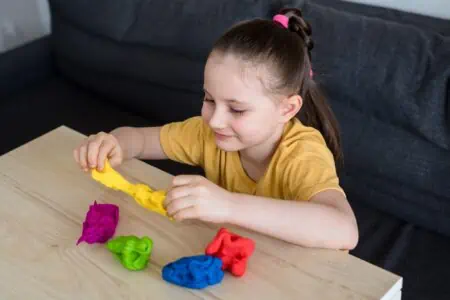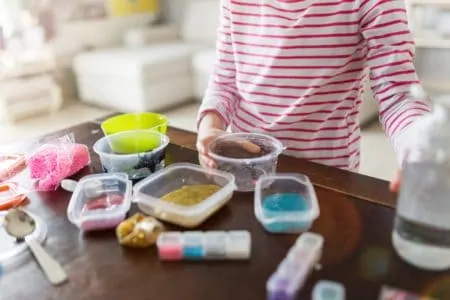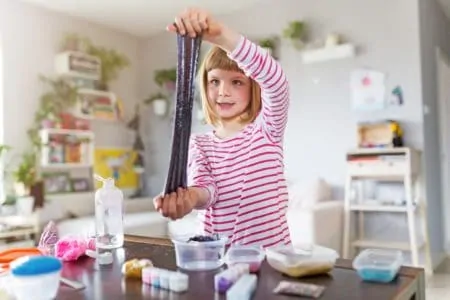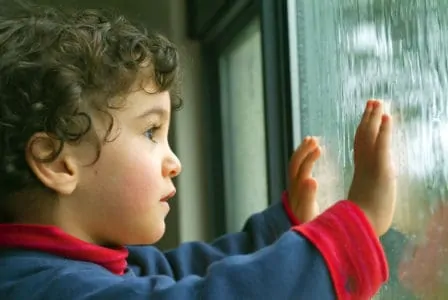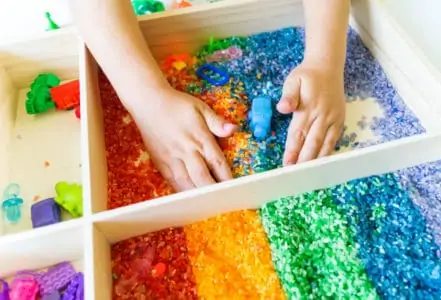We created these step-by-step instructions for making homemade playdough without cream of tartar. You only need four essential pantry ingredients and five simple steps. Your kids will be squishing and molding in no time.
Below, we cover the recipe and creative ways to customize the dough with different colors, scents, and textures. Let’s get ready for some budget-friendly, non-toxic fun.
What Do You Need To Make Playdough?
Creating homemade playdough without cream of tartar is easy and requires no baking. It is a fantastic sensory activity for preschoolers and helps develop fine motor skills.
Here are the pantry staples you need:
- Flour: Two cups of plain, all-purpose flour.
- Salt: Half a cup of fine table salt.
- Oil: Two tablespoons of vegetable oil or baby oil.
- Water: One cup of water (hot or boiling works best).
- Color: Food coloring or gel paste (optional).
Traditional recipes use cream of tartar to keep the dough soft and act as a preservative. However, you can easily skip it.
If you want a smoother texture without cream of tartar, add two tablespoons of distilled white vinegar or lemon juice. The acidity reacts with the mixture to improve elasticity and stabilize the dough so it lasts longer.
Lemon Juice Swap
You can substitute vinegar with lemon juice. Add two tablespoons of lemon juice to your wet ingredients. It adds softness, acts as a natural preservative, and gives the dough a fresh, citrusy scent.
How To Make Homemade Playdough Without Cream of Tartar
Get ready for hours of entertainment with this simple, no-cook playdough recipe.
Instructions
- Mix dry ingredients: Combine the flour and salt in a large mixing bowl. Stir until well blended.
- Add acid (optional): If you are using vinegar or lemon juice for extra softness, add it now.
- Add wet ingredients: Pour the vegetable oil and water into the bowl. Hot or boiling water helps dissolve the salt faster for a smoother texture. Mix well with a spoon.
- Add color: If you want one color for the whole batch, stir the food coloring into the water before mixing. For multiple colors, separate the plain dough into balls and knead drops of color into each one later.
- Knead the dough: Dump the mixture onto a floured surface. Knead for about 10 minutes until it feels smooth, elastic, and no longer sticky.
Fun Variations for Your Recipe
Standard playdough is fun, but adding texture and scent makes it even better. This is a great opportunity to teach kids about different senses. Try these creative mix-ins:
- Glitter: Fold in eco-friendly glitter for a sparkle effect.
- Essential oils: Add a drop of lavender, peppermint, or orange oil for aromatherapy while they play.
- Cocoa powder: Replace a small amount of flour with cocoa powder for “mud” dough that smells like chocolate.
- Kool-Aid: Use drink mix packets to add both vibrant color and a fruity scent.
- Cornmeal or Rice: Mix in dry grains to create a gritty texture for sensory exploration.
- Nature items: Press dried flowers or herbs into the dough for a botanical theme.
- Glow paint: Mix in a little non-toxic glow-in-the-dark paint for nighttime fun.
Tips for the Perfect Batch
Homemade playdough is forgiving, but a few tricks ensure it comes out pliable and smooth every time.
- Measure accurately: Baking is a science. Use proper measuring cups rather than guessing to get the right consistency.
- Don’t skip kneading: The dough might look messy at first. Kneading aligns the proteins in the flour, which creates that satisfying, stretchy texture. Set a timer for 10 minutes.
- Dissolve the salt: Using boiling water helps dissolve salt granules. If you use cold water, the dough might feel grainy.
- Troubleshoot stickiness: If the dough sticks to your hands, add flour one tablespoon at a time. If it cracks or feels dry, work in a teaspoon of water or oil.
- Add color last: For less mess, mix the dough plain first. Then, divide it up and add color to individual portions in plastic bags to keep your hands clean.
- Choose the right oil: Vegetable oil or coconut oil works well. Baby oil makes the dough smell great and feel extra soft.
FAQs
Ready to Play?
Homemade playdough is one of the easiest DIY activities you can do at home. You save money by skipping the store-bought brands, and you know exactly what ingredients are going into your child’s hands.
Whether you use vinegar, lemon juice, or just plain water, this recipe creates hours of open-ended play. It is perfect for rainy days, playdates, or quiet afternoons. Grab your flour and salt, and let the creativity begin.
